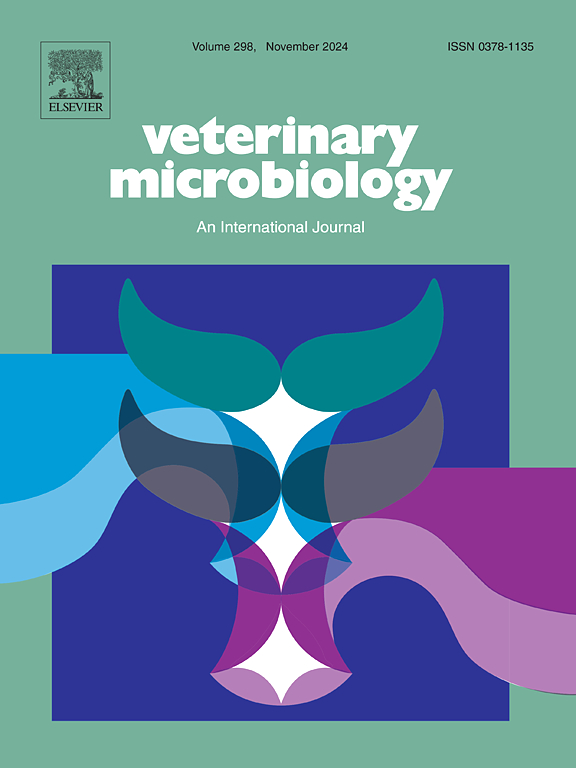A candidate multi-epitopes vaccine against encephalomyocarditis virus confers protection in mice
IF 2.4
2区 农林科学
Q3 MICROBIOLOGY
引用次数: 0
Abstract
Encephalomyocarditis virus (EMCV) is a widely distributed RNA virus that causes diseases in animals with zoonotic potential. Infection with this pathogen in animals, especially in pigs, can lead to encephalitis, myocarditis, and reproductive disorders. The virus causes a febrile disease in humans and is thus not only a potential threat to the swine industry but also to human health and society. However, there is still no commercial EMCV vaccine available, making the development of a novel and effective EMCV vaccine a priority. Here, we developed an EMCV multi-epitopes candidate vaccine, MIgH-EMCV-Ⅱ2D2, by directly concatenating universal T-cell epitope sequences with B-cell epitopes of EMCV structural proteins VP1, VP2, and VP3 in a tandem manner. Vaccination of MIgH-EMCV-Ⅱ2D2 formulated with adjuvants FCA / FIA induces neutralizing antibodies against EMCV, and also elicits a robust Th1-dominant cellular immune response in vivo against EMCV. Furthermore, our MIgH-EMCV-Ⅱ2D2 vaccine showed stronger protection in mice in the prime-boost regimen than the single-dose regimen. The MIgH-EMCV-Ⅱ2D2 vaccination conferred complete protection against live EMCV PV21 strain challenge with a 100 % survival rate. These results indicate that the MIgH-EMCV-Ⅱ2D2 vaccine is a promising, safe, and effective vaccine candidate and could potentially be used for the prevention and control of EMCV.
一种抗脑心肌炎病毒候选多表位疫苗对小鼠具有保护作用
脑心肌炎病毒(EMCV)是一种广泛分布的RNA病毒,在动物中引起疾病,具有人畜共患的潜力。动物,特别是猪感染这种病原体可导致脑炎、心肌炎和生殖障碍。该病毒引起人类发热性疾病,因此不仅对养猪业构成潜在威胁,而且对人类健康和社会构成潜在威胁。然而,目前仍没有商业化的EMCV疫苗,这使得开发一种新型有效的EMCV疫苗成为当务之急。本研究通过将通用t细胞表位序列与EMCV结构蛋白VP1、VP2和VP3的b细胞表位直接串联,开发了EMCV多表位候选疫苗may -EMCV-Ⅱ2D2。用佐剂FCA / FIA配制的might -EMCV-Ⅱ2D2疫苗可诱导针对EMCV的中和抗体,并在体内引发针对EMCV的强大的th1显性细胞免疫应答。此外,我们的might - emcv -Ⅱ2D2疫苗在小鼠中表现出比单剂量方案更强的保护作用。might -EMCV-Ⅱ2D2疫苗对EMCV PV21活株的攻击具有完全的保护作用,存活率为100% %。这些结果表明,mmight -EMCV-Ⅱ2D2疫苗是一种有前景的、安全有效的候选疫苗,可能用于预防和控制EMCV。
本文章由计算机程序翻译,如有差异,请以英文原文为准。
求助全文
约1分钟内获得全文
求助全文
来源期刊

Veterinary microbiology
农林科学-兽医学
CiteScore
5.90
自引率
6.10%
发文量
221
审稿时长
52 days
期刊介绍:
Veterinary Microbiology is concerned with microbial (bacterial, fungal, viral) diseases of domesticated vertebrate animals (livestock, companion animals, fur-bearing animals, game, poultry, fish) that supply food, other useful products or companionship. In addition, Microbial diseases of wild animals living in captivity, or as members of the feral fauna will also be considered if the infections are of interest because of their interrelation with humans (zoonoses) and/or domestic animals. Studies of antimicrobial resistance are also included, provided that the results represent a substantial advance in knowledge. Authors are strongly encouraged to read - prior to submission - the Editorials (''Scope or cope'' and ''Scope or cope II'') published previously in the journal. The Editors reserve the right to suggest submission to another journal for those papers which they feel would be more appropriate for consideration by that journal.
Original research papers of high quality and novelty on aspects of control, host response, molecular biology, pathogenesis, prevention, and treatment of microbial diseases of animals are published. Papers dealing primarily with immunology, epidemiology, molecular biology and antiviral or microbial agents will only be considered if they demonstrate a clear impact on a disease. Papers focusing solely on diagnostic techniques (such as another PCR protocol or ELISA) will not be published - focus should be on a microorganism and not on a particular technique. Papers only reporting microbial sequences, transcriptomics data, or proteomics data will not be considered unless the results represent a substantial advance in knowledge.
Drug trial papers will be considered if they have general application or significance. Papers on the identification of microorganisms will also be considered, but detailed taxonomic studies do not fall within the scope of the journal. Case reports will not be published, unless they have general application or contain novel aspects. Papers of geographically limited interest, which repeat what had been established elsewhere will not be considered. The readership of the journal is global.
 求助内容:
求助内容: 应助结果提醒方式:
应助结果提醒方式:


